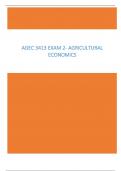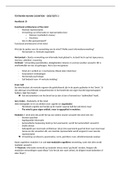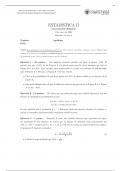Geco - Guías de estudio, Notas de estudios & Resúmenes
¿Buscas las mejores guías de estudio, notas de estudio y resúmenes para Geco? En esta página encontrarás 14 documentos de estudio para Geco.
All 14 resultados
Ordenador por
AGEC 3413 Exam 2 - Agricultural Economics Questions and Answers

-
AGEC 429 past test questions (100% Recommended)
- Examen • 5 páginas • 2023
-
Disponible en paquete
-
- 8,98 €
- + aprende más y mejor
A lot of attention has been focused on the forces of change in agriculture. List one of the forces discussed in class and provide an example of how it acts as a force of change in agricultural policy. correct answers Globalization- US depends on trade It was mentioned in class that Senators often have a broader perspective on policy issues than members of the House of Representatives? Why? correct answers Senators often have a broader perspective, because they have a longer term in office (6 ...
Collectie van 3 documenten Alle deeltentamens voor het van Human Cognition
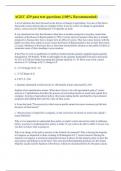
-
AGEC 429 past test questions (100% Recommended)
- Examen • 5 páginas • 2023
-
Disponible en paquete
-
- 10,40 €
- + aprende más y mejor
A lot of attention has been focused on the forces of change in agriculture. List one of the forces discussed in class and provide an example of how it acts as a force of change in agricultural policy. correct answers Globalization- US depends on trade It was mentioned in class that Senators often have a broader perspective on policy issues than members of the House of Representatives? Why? correct answers Senators often have a broader perspective, because they have a longer term in office (6 ...
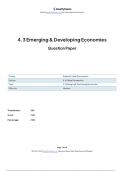
-
4.3- Emerging & DevelopingEconomies- A level Economics Edexcel Exam Questions
- Examen • 19 páginas • 2024
-
Disponible en paquete
-
- 3,65 €
- + aprende más y mejor
Memorsing content can only take you so far, so use exam questions effectively to prepare yourself for the actual exam. This document will help you do so, it contains exam questions for this spec point. [A Level Economics Edexcel A, Exam Questions]
Enero
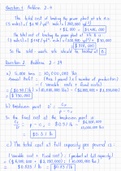
-
HW3_Cost Concepts and Design Economics_EngEconomics
- Otro • 3 páginas • 2023
-
Disponible en paquete
-
- 2,83 €
- + aprende más y mejor
Cost concepts refer to the various types of costs that are involved in a project, including direct costs (such as labor and materials) and indirect costs (such as overhead and administration expenses). These costs are analyzed and quantified in order to determine the total cost of a project. Understanding cost concepts is important for engineers because it allows them to accurately estimate the costs associated with a project and identify areas where cost savings can be made. Design economics...
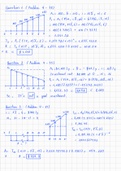
-
HW6_Uniform and Geometric Gradients_EngEconomics
- Otro • 2 páginas • 2023
-
Disponible en paquete
-
- 2,83 €
- + aprende más y mejor
Uniform gradients are cash flows in which the payment or receipt is the same amount for each period. For example, a uniform gradient might be a series of annual payments of $10,000 over the next five years. Engineers use uniform gradient calculations to evaluate investments and financial decisions with constant cash flows. They can use the present worth factor to calculate the value of a uniform gradient, taking into account the time value of money and the interest rate. Geometric gradients, ...
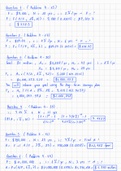
-
HW4_Equivalence Calculations_P,F,A,N_EngEconomics
- Otro • 2 páginas • 2023
-
Disponible en paquete
-
- 2,83 €
- + aprende más y mejor
Equivalence calculations using the four factors - present worth (P), future worth (F), annual worth (A), and nominal rate (N) - are commonly used to compare and evaluate alternative investment options. Present worth (P) is the value today of a series of future cash flows, calculated by discounting them using a given interest rate. Future worth (F) is the value at a future time of a series of present cash flows, calculated by compounding them using a given interest rate. Annual worth (A) is th...
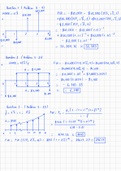
-
HW7_Profitability Measures (PW, FW, AW)_EngEconomics
- Otro • 2 páginas • 2023
-
Disponible en paquete
-
- 2,83 €
- + aprende más y mejor
The three most commonly used profitability measures are present worth (PW), future worth (FW), and annual worth (AW). Each measure provides a different perspective on the profitability of an investment, and engineers can use them in combination to make informed decisions about the use of resources. Present worth (PW) is the value of all future cash flows of an investment at the present time. Engineers use the present worth factor to calculate the present worth of an investment, taking into ac...

5,99 euros por el resumen de tu libro de texto multiplicado por 100 compañeros... Haz cuentas: ¡eso es mucho dinero! No seas ladrón de tu propia cartera y empieza ya a subir el tuyo. Descubre todo sobre cómo ganar en Stuvia

